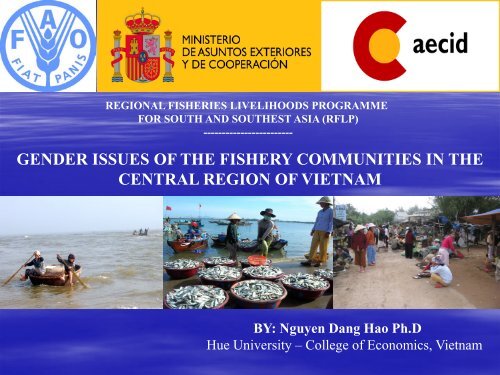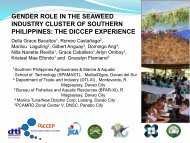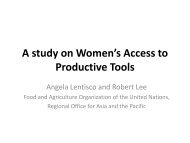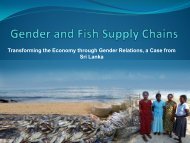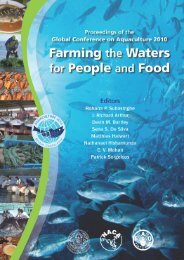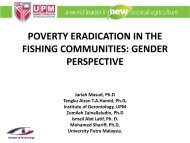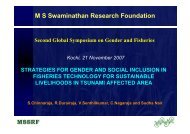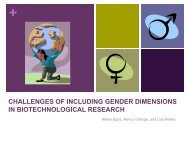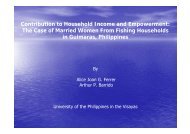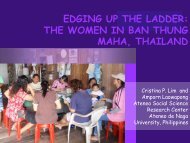Nguyen Dang Hao - GENDER IN AQUACULTURE AND FISHERIES
Nguyen Dang Hao - GENDER IN AQUACULTURE AND FISHERIES
Nguyen Dang Hao - GENDER IN AQUACULTURE AND FISHERIES
Create successful ePaper yourself
Turn your PDF publications into a flip-book with our unique Google optimized e-Paper software.
REGIONAL <strong>FISHERIES</strong> LIVELIHOODS PROGRAMME<br />
FOR SOUTH <strong>AND</strong> SOUTHEST ASIA (RFLP)<br />
------------------------<br />
<strong>GENDER</strong> ISSUES OF THE FISHERY COMMUNITIES <strong>IN</strong> THE<br />
CENTRAL REGION OF VIETNAM<br />
BY: <strong>Nguyen</strong> <strong>Dang</strong> <strong>Hao</strong> Ph.D<br />
Hue University – College of Economics, Vietnam
Presentation Content:<br />
Introduction<br />
Methodology<br />
Findings<br />
Conclusion and policy implications
<strong>IN</strong>TRODUCTION<br />
Coastal Central region<br />
Crowded population<br />
and mainly living in rural<br />
areas<br />
High vulnerability:<br />
Natural disasters:<br />
typhoons, floods,<br />
droughts<br />
Poor resource<br />
endowment (low land<br />
area per capita,<br />
sand land infertility),<br />
Under-developed<br />
infrastructure<br />
High incidence of poverty, most of them are women<br />
Environmental degradation<br />
Lagged behind and low-transferred economy<br />
3
OBJECTIVES OF THE STUDY<br />
Assess the existing gender relations related to<br />
economic position such as the division of labour between<br />
men and women, income, access to resources and<br />
benefits.<br />
Identifying the factors that influence or determine the<br />
women’s access to resources and benefits, their<br />
participation in the social network and rural<br />
organizations.<br />
Identifying the possible policy to improve the gender<br />
issues of the fishery communities in the Central region .
METHODOLOGY<br />
Qualitative assessment:<br />
Participatory gender assessment<br />
Using several tools of Participatory<br />
Rural Appraisal (PRA): trend<br />
analysis, day-time use analysis,<br />
social mapping, Venn diagram, lifeline,<br />
and ranking matrices.<br />
Various relevant stakeholders at<br />
multi levels<br />
Farmers groups<br />
Villages<br />
Commune<br />
District<br />
Province
STUDY SITES<br />
QuangTri: 5 communes<br />
Thua Thien Hue: 5 communes<br />
Quang Nam: 6 communes<br />
6
F<strong>IN</strong>D<strong>IN</strong>GS<br />
1. Human capital<br />
Family size:<br />
More crowded family (6prs vs 4.3prs)<br />
High frequency of the families have more than three<br />
children, WHY<br />
Traditional culture beliefs give overestimated value to<br />
men who are mainly responsible for fishing – the main<br />
income source of the majority of the households<br />
Every couple, husband in particular wants to have a boy<br />
Overload to women for both birth giving and<br />
housework<br />
Longer working day: 12-14 hours vs 9-10 hours<br />
the
F<strong>IN</strong>D<strong>IN</strong>GS<br />
1. Human capital (cont.)<br />
Education and access to training:<br />
Low literacy: 80% is under secondary<br />
About 10-15% of labor force is illiteracy, most of<br />
them are women<br />
Majority of children stop their study earlier for<br />
involving in earning living, girls in particular<br />
Higher dropout rate for girls since their parents give<br />
priority to the boys<br />
Over 80% at the age of working do not have<br />
professional trainings and women have fewer access<br />
to the trainings
F<strong>IN</strong>D<strong>IN</strong>GS<br />
2. Access to resources<br />
Big challenge due to open access to sea and lagoon<br />
Rapid increase in a number of boats and fishing nets<br />
Destructive fishing equipments<br />
Overfishing<br />
Low awareness about community-based as well as comanagement<br />
mechanisms<br />
Low financial and physical capitals<br />
Voice of women is low for the sharing property rights<br />
since men often take more power in decision making<br />
Women have more access to credit but they are lack of<br />
knowledge to manage loans
F<strong>IN</strong>D<strong>IN</strong>GS<br />
3. Access to social capital<br />
Rate of households participating into social networks (%)<br />
Women Union and Farmers Association are the most important<br />
organizations in the study sites
F<strong>IN</strong>D<strong>IN</strong>GS<br />
3. Access to social capital (cont.)<br />
Major benefits gained from participation at WU and FA<br />
related activities (% of surveyed households)<br />
Others<br />
Gifts<br />
Study tour<br />
Sharing experience<br />
Credit<br />
Trainings<br />
Learning from each other<br />
Encouragement and sympathy<br />
0 10 20 30 40 50 60 70 80 90<br />
Their participation are passive and not regular
F<strong>IN</strong>D<strong>IN</strong>GS<br />
3. Access to social capital (cont.)<br />
Women rarely participate the meetings organized by<br />
the villages, communes<br />
No place for women in traditional beliefs<br />
Women’s voice is less respected by men<br />
Meetings are often at night, not suitable for<br />
women<br />
Low rate of women represented in the organizations<br />
at various levels: village, commune, district and<br />
province
F<strong>IN</strong>D<strong>IN</strong>GS<br />
4. Main income generation activities<br />
1. Fishing 4.2. Sea product trade<br />
1.1. Onshore 4.3. Input trade<br />
1.2. Offshore 5. Processing<br />
1.3. River and lagoon 5.1. Fish sauce<br />
2. Aquaculture 5.2. Dried fish<br />
2.1. Shrimp 6. Service<br />
2.2. Fish 6.1. Tourism<br />
3. Agriculture 6.2. Transportation, repair, milling<br />
3.1. Crop: rice, sweet potato, cassava,<br />
vegetable, seeds<br />
7. Hired labor<br />
3.2. Husbandry: pig, chicken, duck, cow 8. Migration<br />
4. Trade<br />
4.1. Miscellaneous trade
F<strong>IN</strong>D<strong>IN</strong>GS<br />
4. Main income generation activities (cont)<br />
Fishing is the most important, but very risky<br />
Natural disasters: many fishermen were annually killed<br />
Chanchu killed 257 fishermen, some villages became<br />
widow ones.<br />
Fishermen high aware about regulation on safety at sea, but<br />
they are bad practice.<br />
Fish output gradually decrease, but cost for fishing<br />
increase rapidly<br />
Aquaculture is new emerging, but very risky too<br />
Unsustainable practice<br />
Widespread of disease<br />
Unstable market<br />
Limited alternative income activities
F<strong>IN</strong>D<strong>IN</strong>GS<br />
4. Labor division b/w men and women<br />
Women are fewer opportunities to work in some activities<br />
because they are considered as bad luck
F<strong>IN</strong>D<strong>IN</strong>GS<br />
5. Income contributed by men and women<br />
Women’s income is lower, although their working day is<br />
longer<br />
Fewer opportunities to work in fishing and<br />
aquaculture which could generate high income.<br />
Most women’s income is from trade, processing, husbandry<br />
and services.<br />
Women’s income of the better-off households is much<br />
more higher than that of the poor women.
Important level of the income generation activities to the<br />
better-off households in Duy Hai commune<br />
1. Fishing (boat owner)<br />
F<strong>IN</strong>D<strong>IN</strong>GS<br />
Contribution to<br />
household income<br />
(1000VND/year)<br />
%<br />
contributed<br />
to total<br />
income<br />
100.000 -150.000 90<br />
Level *<br />
2<br />
(%) contributed<br />
by<br />
Men<br />
100<br />
Women<br />
2. Trade 120.000 -150.000 70 1 20 80<br />
3. Sea product wholesale 100.000 -150.000 60 2 80 20<br />
4. Processing 150.000 - 250.000 90 1 20 80<br />
5. Migration 5.000 -10.000 10 5 30 70<br />
Note: form 1=very important to 5= least important
F<strong>IN</strong>D<strong>IN</strong>GS<br />
Important level of the income generation activities to the<br />
average households in Duy Hai commune<br />
Contribution to<br />
household income<br />
(1000VND/year)<br />
%<br />
contributed<br />
to total<br />
income<br />
Level *<br />
(%) contributed<br />
by<br />
Men<br />
Women<br />
1. Fishing (small boat<br />
owner, sharing)<br />
40.000 - 50.000<br />
80 1<br />
100<br />
2. Small collector 25.000 - 30.000 20 3 60 40<br />
3. Small trade 15.000 - 20.000 20 3 100<br />
4. Small scale<br />
processing<br />
10.000 - 20.000 30 3 20 80<br />
5. Agriculture 20.000 - 30.000 30 2 30 70<br />
6. Hired labor 40.000 - 50.000 50 1 50 50<br />
7. Others 20.000 – 30.000 30 2<br />
Note: form 1=very important to 5= least important
F<strong>IN</strong>D<strong>IN</strong>GS<br />
Important level of the income generation activities to the poor<br />
households in Duy Hai commune<br />
1. Petty trade<br />
Contribution to<br />
household income<br />
(1000VND/year)<br />
(%)<br />
% contributed contributed by<br />
to total income Level*<br />
Men<br />
Women<br />
5.000 - 10.000 30 3 20 80<br />
2. Hired labor 15.000 - 20.000 70 1 80 20<br />
3. Others (any work) 10.000 - 15.000 40 2 30 70<br />
4. Agriculture 5.000 – 10.000 20 4 30 70<br />
Note: form 1=very important to 5= least important
CONCLUSIONS<br />
- Thanks to high growth of economy and support policies<br />
introduced by government, the socio-economic opportunities are<br />
significantly improved for both men and women.<br />
-There are many disadvantages to women<br />
Intangible barriers are existing: traditional beliefs,<br />
stereotypes, rural institutions…<br />
Women have less access to and control over resources such as<br />
education, healthcare, information, technology, land and social<br />
capital<br />
Due to burden of housework, traditional beliefs, women have fewer<br />
opportunities to work in the higher income generating activities.<br />
The alternative income activities are limited, most of women are<br />
underemployment.<br />
Lower women’s income makes their position low, their voice is<br />
not respected by men.
POLICY IMPLICATION<br />
1. More innovative solutions for better access to education,<br />
health care, social services, professional trainings for alternative<br />
jobs;<br />
2. Gender mainstreaming should be taken account in rural<br />
development policies related to access to resources, income<br />
generation, development planning and trainings and decision<br />
making process;<br />
3) More support policies for women in economic activities<br />
such as credit, trainings on starting new business, business skills<br />
and transferring technology;<br />
4) Raising awareness about gender for local authorities.
Hope and smile forward future<br />
Thank you


